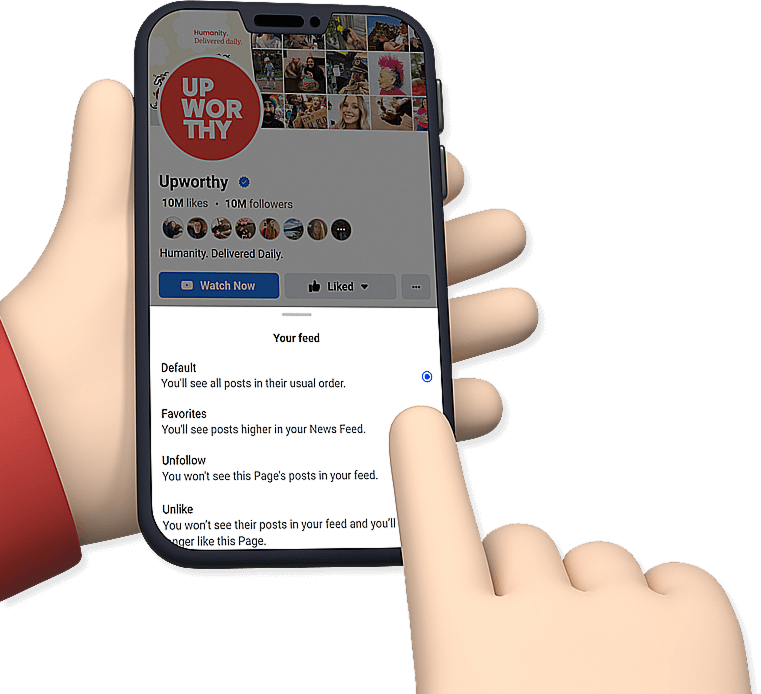101 ways to take care of yourself when the world feels overwhelming.
A therapist shares small ways to practice self-care.
I think that, for most of us, there are times in life when it all just feels like Too Much.
There may be some days, weeks, months, maybe even years when — for whatever reason — just getting through the day or going to work or putting one foot in front of the other feels hard. Really, really hard.
Photo via iStock.
Maybe it’s because you’re wrestling with anxiety, depression, or some other mental illness.
Maybe it’s because you’ve had your heart broken. Maybe you’ve gone through a physical or emotional trauma. Maybe you’re deeply grieving. Or maybe there’s no easily understood reason for why you’re feeling bad.
Whatever the case, I want you to know that it’s OK if you’re going through a tough time.
This doesn’t make you any less lovable, worthy, or capable. This just means you’re human. Being a human can be a messy, hard, confusing, painful experience sometimes.
So if you or someone you love is going through one of these tough times right now, a time where it all just feels like too much, I want to offer up 101 suggestions for self-care to help you or your loved one get through this time.
Photo via iStock.
1. Have a good, long, body-shaking cry.
2. Call a trusted friend or family member and talk it out.
3. Call in sick. Take comp time if you can. Take a mental health day.
4. Say no to extra obligations, chores, or anything that pulls on your precious self-care time.
5. Book a session (or more!) with your therapist.
6. Dial down your expectations of yourself at this time. When you’re going through life’s tough times, I invite you to soften your expectations of yourself and others.
7. Tuck yourself into bed early with a good book and clean sheets.
8. Watch a comforting/silly/funny/lighthearted TV show or movie. ("Parks and Recreation," anyone?)
9. Reread your favorite picture and chapter books from childhood.
10. Ask for some love and tenderness from your friends on social media. Let them comment on your post and remind you that you’re loved.
11. Look at some some really gorgeous pieces of art.
12. Watch YouTube videos of Ellen DeGeneres and the adorable kids she has on her show.
13. Look at faith-in-humanity-restoring lists from around the internet.
14. Ask for help. From whomever you need it — your boss, your doctor, your partner, your therapist, your mom. Let people know you need some help.
15. Wrap yourself up in a cozy fleece blanket and sip a cup of hot tea.
16. Breathe. Deeply. Slowly. Four counts in. Six counts out.
17. Hydrate. Have you had enough water today?
18. Eat. Have you eaten something healthy and nourishing today?
19. Sleep. Have you slept seven to nine hours? Is it time for some rest?
20. Shower. Then dry your hair and put on clothes that make you feel good.
21. Go outside and be in the sunshine.
22. Move your body gently in ways that feel good. Maybe aim for 30 minutes. Or 10 minutes if 30 feels like too much.
23. Read a story (or stories) of people who overcame adversity or maybe dealt with mental illness, too. (I personally admire J.K. Rowling’s story.)
24. Go to a 12-step meeting. Or any group meeting where support is offered. Check out church listings, hospital listings, or school listings, for example.
25. If you suspect something may be physiologically off with you, go see your doctor and/or psychiatrist and talk to them. Medication might help you at this time, and professionals can assist you in assessing this.
26. Take a long, hot bath. Light a candle and pamper yourself.
27. Read inspirational quotes.
28. Cuddle someone or something. Your partner. A pillow. Your friend’s dog.
29. Read previous emails, postcards, letters, etc. from friends and family reminding you of happier times.
30. Knit. Sculpt. Bake. Engage your hands.
31. Exhaust yourself physically — running, yoga, swimming, whatever helps you feel fatigued.
32. Write it out. Go free-form in a journal or on a computer. Get it all out and vent.
33. Create a plan if you’re feeling overwhelmed. List out what you need to do next to tackle and address whatever you’re facing. Chunk it down into manageable and understandable pieces.
34. Remind yourself you only have to get through the next five minutes. Then the next five. And so on.
35. Take five minutes to meditate.
36. Write out a list of 25 reasons you’ll be OK.
37. Write out a list of 25 examples of things you’ve overcome or accomplished.
38. Write out a list of 25 reasons you’re a good, lovable person.
39. Write out a list of 25 things that make your life beautiful.
40. Sniff some scents that bring you joy or remind you of happier times.
41. Ask for support from friends and family via text if voice-to-voice contact feels like too much. Ask them to check in with you via text daily or weekly, whatever you need.
42. Lay down on the ground. Let the Earth or floor hold you. You don’t have to hold it all on your own.
43. Clean up a corner of a room of your house. Sometimes tidying up can help calm our minds.
44. Ask yourself: What’s my next most immediate priority? Do that that. Then ask the question again.
45. Read some poetry. Rumi, Hafiz, and Mary Oliver are all excellent.
46. Take a tech break. Delete or deactivate social media if it feels too triggering right now.
47. Or maybe get on tech. If you’ve been isolating, maybe interacting with friends and family online might feel good.
48. Go out in public and be around others. You don’t have to engage, but maybe sit in a coffee shop or on a bench at a museum and soak up the humanity around you.
49. Or if you’re feeling too saturated with contact, go home. Cancel plans and tend to the introverted parts of yourself.
50. Ask friends and family to remind you that things will be OK and that what you’re feeling is temporary.
51. Put up some Christmas lights in your bedroom. They often make things more magical.
52. Spend a little money and treat yourself to some self-care and comfort. Maybe take a taxi versus the bus. Buy your lunch instead of forcing yourself to pack it. Buy some flowers that delight you.
53. Make art. Scribble with crayons. Splash some watercolors. Paint a rock. Whatever. Just create something.
54. Go wander around outside in your neighborhood and take a look at all the lovely houses and the way people decorate their gardens. Delight in the diversity of design.
55. Go visit or volunteer at your local animal rescue. Pet some animals.
56. Look at photos of people you love. Set them as the wallpaper of your phone or laptop.
57. Create and listen to a playlist of songs that remind you of happier times.
58. Read some spiritual literature.
59. Scream, pound pillows, tear up paper, shake your body to move the energy out.
60. Eat your favorite, most comforting foods.
61. Watch old "Mister Rogers’ Neighborhood" videos online.
62. Turn off the lights, sit down, stare into space, and do absolutely nothing.
63. Pick one or two things that feel like progress and do them. Make your bed. Put away the dishes. Return an email.
64. Go to a church or spiritual community service. Sit among others and absorb any guidance or grace that feels good to you.
65. Allow yourself to fantasize about what you’re hoping or longing for. There are clues and energy in your reveries and daydreams that are worth paying attention to.
66. Watch autonomous sensory meridian response videos to help you calm down and fall asleep at night.
67. Listen to monks chanting, singing Tibetan bowls, or nature sounds to help soothe you.
68. Color in some coloring books.
69. Revisit an old hobby. Even if it feels a little forced, try your hand at things you used to enjoy and see what comes up for you.
70. Go to the ocean. Soak up the negative ions.
71. Go to the mountains. Absorb the strength and security of them.
72. Go to the forest. Drink in the shelter, life, and sacredness of the trees.
73. Put down the personal help books and pick up some good old-fashioned fiction.
74. Remember: Your only job right now is to put one foot in front of the other.
75. Allow and feel and express your feelings — all of them! — safely and appropriately. Seek out help if you need support in this.
76. Listen to sad songs or watch sad movies if you need a good cry. ("Steel Magnolias," anyone?)
77. Dance around wildly to your favorite, most cheesy songs from your high school years.
78. Put your hands in dirt. If you have a garden, go garden. If you have some indoor plants, tend to them. If you don’t have plants or a garden, go outside. Go to a local nursery and touch and smell all the gorgeous plants.
79. If you want to stay in bed all day watching Netflix, do it. Indulge.
80. Watch or listen to some comedy shows or goofy podcasts.
81. Look up examples of people who have gone through and made it through what you’re currently facing. Seek out models of inspiration.
82. Get expert help with whatever you need. Whether that’s through therapy, psychiatry, a lawyer, clergy, or something else, let those trained to support you do it.
83. Educate yourself about what you’re going through. Learn about what you’re facing, what you can expect to feel, and how you can support yourself in this place.
84. Establish a routine and stick to it. Routines can bring so much comfort and grounding in times of life that feel chaotic or out of control.
85. Do some hardcore nesting and make your home or bedroom as cozy and beautiful and comforting as possible.
86. Get up early and watch a sunrise.
87. Go outside, set up a chair, and watch the sunset.
88. Make your own list of self-soothing activities that engage all five of your senses.
89. Develop a supportive morning ritual for yourself.
90. Develop a relaxing evening ritual for yourself.
91. Join a support group for people who are going through what you’re going through. Check out the listings at local hospitals, libraries, churches, and universities to see what’s out there.
92. Volunteer at a local shelter or hospital or nursing home. Practice being of service to others who may also be going through a tough time.
93. Accompany a friend or family member to something. Even if it’s just keeping them company while they run errands, sometimes this kind of contact can feel like good self-care.
94. Take your dog for a walk. Or borrow a friend’s dog and take them for a walk.
This kangaroo dog loves walks.
95. Challenge your negative thinking.
96. Practice grounding, relaxation techniques.
97. Do something spontaneous. Walk or drive a different way to work. Order something new off the menu. Listen to a playlist of new songs.
98. Work with your doctor, naturopath, or nutritionist to develop a physical exercise plan and food plan that will be supportive to whatever you’re facing right now.
99. Pray. Meditate. Write a letter to God, the universe, the Source, your higher self — whatever you believe in.
100. As much as you can, try and trust the process.
101. Finally, remember, what you’re going through right now is temporary. It may not feel like that from inside the tough time you’re in, but this too shall pass and you will feel different again someday. If you can’t have faith in that, let me hold the hope for you.
This list is really just a starting point meant to catalyze your own thinking about how you can best take care of yourself during life’s tough times and to spark your curiosity and interest in strengthening your self-care now and ongoing.
It's not meant to be prescriptive nor do I mean to imply you need to do all or any of these things to take good care of yourself. You are the expert of your own experience, and I trust that you know what’s best for you.
Also, my hope is that in reading this, you’re hearing me say how normal and natural it is to struggle and to have these tough, hard times. It’s part of being human.
You’re not alone in this.
GIF via "Friends."
- Collection of recipes from around the world aims to raise awareness about food insecurity ›
- Guys save church money by fixing clock tower with WD-40 - Upworthy ›
- Therapist and mom helps struggling parents by explaining care tasks are ‘morally neutral' - Upworthy ›
- Believe it or not, there was a very real global 'pandemic of benevolence' in 2021 - Upworthy ›
- What would you tell your 13-year-old self? - Upworthy ›
- The Cinema Therapy guys literally make movie-watching therapeutic - Upworthy ›
- Redditors share the best small talk topics - Upworthy ›
- Matthew McConaughey wants to ban a word - Upworthy ›
- National Cinema Day is September 3 - Upworthy ›
- 19 self-care habits that can have a big impact - Upworthy ›
- 19 self-care habits that can have a big impact - Upworthy ›
- Don’t let digital eye strain sideline you - Upworthy ›
- Astronaut explains the overview effect - Upworthy ›
- Astronaut explains the overview effect - Upworthy ›
- People who deserve more sympathy - Upworthy ›
- People who deserve more sympathy - Upworthy ›
- Candid lessons that helped a young, grieving widow learn to live after loss. - Upworthy ›
- Thai lounge singer sounds like Louis Armstrong - Upworthy ›
- Younger generations have 'menu anxiety' - Upworthy ›
- Over 200,000 people have signed up to storm Area 51 and get the truth about aliens. - Upworthy ›
- Fathers need to care for themselves as well as their kids – but often don’t. - Upworthy ›
- Blogger makes small changes, sees big improvement - Upworthy ›
- Woman shares her self-care tip for avoiding work stress - Upworthy ›
- Wellness experts breaks down myths about spending money on self-care - Upworthy ›
- Wellness expert explains what 'self-care' really is and it's far from what we've been sold - Upworthy ›
- Get a better night's sleep with these Amazon finds - Upworthy ›
- Teacher's poetry exercise helped student struggling with suicide - Upworthy ›







 Carole and her band mates.Carole Wade
Carole and her band mates.Carole Wade A man kissing a woman near the ocean. Photo by
A man kissing a woman near the ocean. Photo by  A doctor examining a patient's wrist with a stethoscope Photo by
A doctor examining a patient's wrist with a stethoscope Photo by  Two men play chess. Photo by
Two men play chess. Photo by  Boop-boop-be-dupe the patriarchy.
Boop-boop-be-dupe the patriarchy.  She was the master of "strategic infantilization."
She was the master of "strategic infantilization."  Assuming girls are dumb because of their voice? As if!
Assuming girls are dumb because of their voice? As if!  Voice as branding? That's hot.
Voice as branding? That's hot.  Does this voice make you want a hotdog real bad?
Does this voice make you want a hotdog real bad?  It's called neo-feminism, bestie.
It's called neo-feminism, bestie.  Office Space Case Of The Mondays GIF
Office Space Case Of The Mondays GIF  Season 1 Episode 6 GIF by The Roku Channel
Season 1 Episode 6 GIF by The Roku Channel  Judging Mean Girls GIF by Magic Radio
Judging Mean Girls GIF by Magic Radio